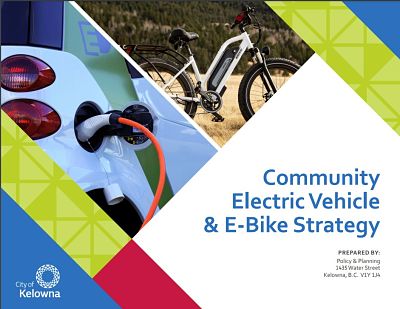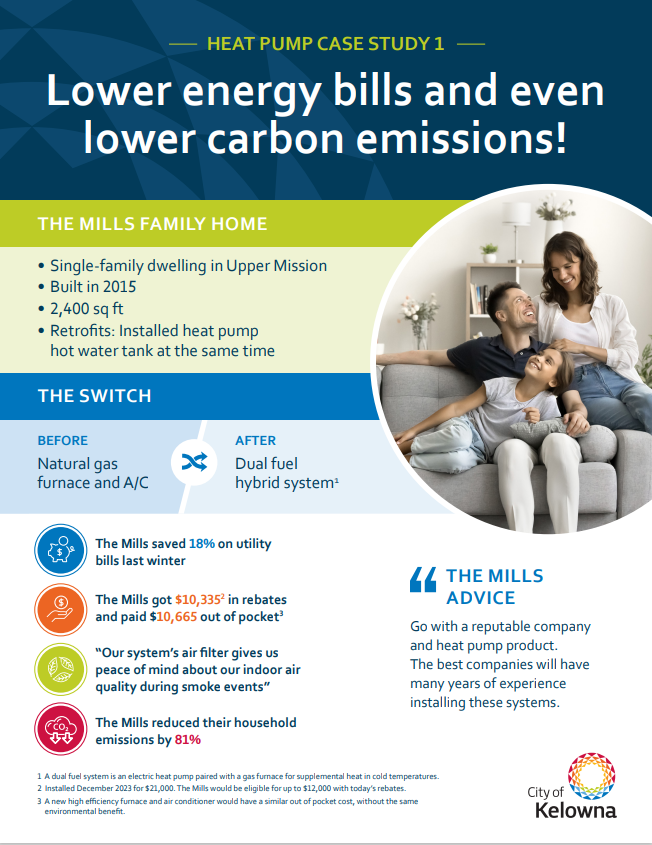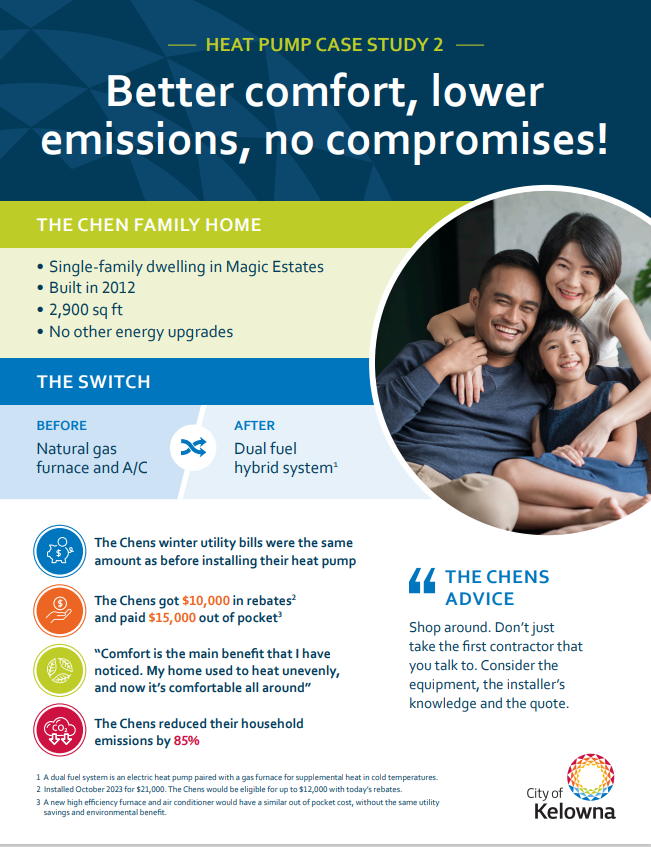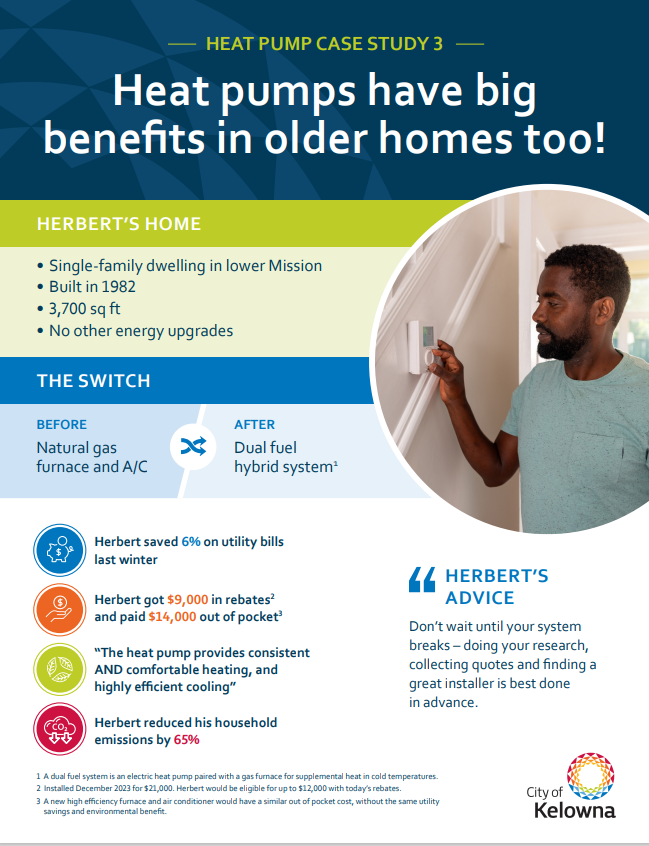Energy
Current City of Kelowna rebate top-up programs
Thinking about installing EV chargers in your multi-unit residential building?
The City of Kelowna has partnered with the Province of British Columbia and FortisBC to offer top-up rebates to building owners and strata councils for implementing EV charging solutions. The current rebate offerings including top-ups are the following:
- EV ready plan rebate: up to 100 percent of the costs, to a maximum of $4,000 to develop an EV Ready plan for a building.
- EV ready infrastructure rebate: up to 75 percent of the infrastructure and installation costs, to a maximum of $800 per parking stall, and a project maximum of $130,000.
- EV charger rebate: up to 75 percent of the costs, to a maximum of $4,000 per charging station.
By applying for existing rebates through FortisBC, you will be automatically considered for the City's top-up offer if eligible. Click on the link above for full program and eligibility information. Act fast - limited rebates are available and this offer expires March 31, 2026.


The way we use energy in Kelowna generates a lot of the city’s greenhouse gas (GHG) emissions, as outlined in the Community Climate Action Plan. To help the community transition to lower GHG emissions (and consequently reduce energy use), we’re working on several strategies and programs to help achieve our short-term 2023 GHG emissions reduction target:
We have partnered with FortisBC and the Okanagan Regional Library (ORL) to help address inefficient homes through the See the Heat thermal imaging camera program. Residents can borrow a thermal imaging camera that connects to a smartphone to learn more about the energy efficiency of their home (e.g. how well your house is insulated, how well doors and windows seal, what plug ins and outlets are particularly leaky, etc.).
- Borrow a thermal imaging camera kit from any Kelowna ORL branch. The kit includes:
- FLIR thermal imaging camera and case
- Charging cable
- Micro-USB to USB-C Adaptor (supplied for Android phone users)
- Kill-A-Watt Meter (to measure loads of electrical appliances)
- Instruction guides
- FortisBC draft-proofing kit (while quantities last)
- Note: Due to high demand, cameras are loaned for a maximum of seven days. There is a late fine of $1 per day. The replacement cost for lost or damaged cameras is $272.
- At home, follow the instructions in the instruction guide provided
- Complete some minor retrofits using the FortisBC draft-proofing kit (if applicable). See the section on "Draft proofing support" for instructional videos on how to use the draft-proofing kit items.
- Return all of the borrowed items to your ORL branch so that the next patron may enjoy it. If you received one of the limited-quantity FortisBC draft-proofing kits, it's yours to keep!
- Complete this quick survey for a chance to win a prize.
The See the Heat program uses FLIR One imaging cameras. If you’re having issues with the camera or want a better understanding of easy ways to use it in your own home, these support links may help:
- How to use the FLIR ONE thermal imaging camera
- Checking a house for missing insulation with FLIR ONE
- Tracking down moisture issues with Jason Cameron & FLIR ONE
- Thermal imaging 101 with FLIR ONE
For technical support, visit FLIR.CustHelp.com
View quick how-to videos on the materials included in the draft-proofing kit supplied with the camera:
- Reducing electrical switch and outlet drafts
- Insulate windows
- Weather-stripping a door
- Weather-stripping windows
The "Energy efficiency in existing buildings" section below outlines additional rebates and incentives you can access to continue to improve the energy efficiency of your home.
Need help navigating complex energy upgrades? Connect with a free Energy Concierge today!
The City of Kelowna has partnered with City Green Solutions and the Home Energy Navigator Program to provide home energy efficiency support and resources to Kelowna residents. An Energy Concierge will guide you through learning what energy efficiency means for your home, identifying what upgrades are best suited to your home and priorities, and help you take the first steps to improving your home’s comfort.
The Home Energy Navigator program offers a five step process to support you through your home energy retrofit journey. Whether you are just starting, or halfway through, Home Energy Navigator is here to help.
Not sure where to start? There are several options to learn about energy efficiency opportunities for your home or business:
- Energy advisor support for your home: A home energy evaluation from an Energy Advisor will help you learn the best energy retrofit options available for your home and how to work energy efficiency retrofits into your renovation plans.
- Energy-saving support for your small business: FortisBC in partnership with GreenStep Solutions is offering complimentary energy assessments to small and medium-sized businesses. Request a free energy assessment, which will provide customized advice about ways to lower energy consumption, including equipment upgrades that are eligible for rebates. The assessments typically take no more than 30 minutes, and focus on the following areas:
- Technical help to turn down a building if it’s closed or under decreased operating hours due to the current pandemic restrictions
- Low-to-no-cost tips for reducing energy usage and operating costs
- Information about rebates and incentives for upgrading to high efficiency equipment
- Kelowna's See the Heat program: Borrow a thermal imaging camera from one of Kelowna's Okanagan Regional Library branches to identify inefficient areas of your building. For more information, see the drop-down menu above on See the Heat.
- Talk to an Energy Coach for FREE: The Energy Coach is a free coaching service for homeowners and commercial building owners and managers in B.C., provided through the Provincial Better Homes Program. Energy coaches are trained energy efficiency specialists who provide building-science based information about the options and opportunities to improve the energy efficiency of your home or building.
- BC Housing Best Practice Guide: Air Sealing and Insulation Retrofits: Provided by BC Housing, this is a resource to learn about the options to improve the energy efficiency of your home through air sealing and insulation.
- FortisBC energy saving tips: Find low- and no-cost ways to save energy, plus buying advice for energy-efficient products
Once you've identified some problems areas, it's time to fix them. Fortunately, there are many rebates available that cover a wide spectrum of energy efficient products and services. Visit the following links to find out how to save:
- CleanBC Better Homes: Find rebate incentives for your existing residential home, new residential home, existing commercial building or new commercial building
- FortisBC rebates and offers: FortisBC has a variety of rebates and offers for products and services to help make your home or business more energy efficient
The Energy Step Code is a provincial policy that aims to create healthier, more efficient and more comfortable buildings. Kelowna has adopted the Energy Step Code in advance of the Province making it mandatory. As of June 1, 2021:
- All Part 9 residential building permit applications must meet or exceed Step 3.
- All Part 3 building development and rezoning applications must meet or exceed Step Code requirements set out in the Implementation Strategy for Part 3 Buildings. Step Code requirements for Part 3 building permit applications come into effect January 1, 2022.
Visit kelowna.ca/energystepcode for details.
Transportation accounts for approximately 53 per cent of Kelowna's GHG emissions. We have been working to transition from our car-centric culture by building more compact, complete communities and promoting cycling, walking, public transit and ride sharing. Electric vehicles (EVs) can also play a significant role in reducing transportation emissions and we’re supporting the transition to this technology in a variety of ways.
Kelowna's Community Electric Vehicle and E-Bike Strategy envisions a city where charging an EV and riding an E-Bike is easy, convenient, and affordable. The Strategy focuses on implementing actions to support the following objectives: 
- Increasing access to EV charging on private property;
- Expanding the public EV charging network;
- Increasing awareness and knowledge level of EVs, EV charging options, and E-bikes among residents;
- Supporting and accelerating fleet and shared mobility (e.g. carshare, bikeshare, ridesharing, ride-hailing) electrification; and
- Expanding E-bike infrastructure and improve E-Bike affordability.
To support EV ownership in Kelowna, the City (in partnership with FortisBC) has installed:
- Two public Level 2 charging stations: These are located at the Okanagan Heritage Museum. Level 2 chargers can charge a vehicle 20-30 per cent in approximately two hours and can provide a full charge in four to five hours for most battery electric vehicles.
- Four Level 3 DC Fast charging stations: Two are located at the airport, and one is located at the Okanagan Heritage Museum and Rutland Centennial Park. DC Fast charging stations can provide an 80-100 per cent charge in half an hour.
Private industry is also helping expand the community's EV charging network. Visit plugshare.com for an interactive map of locations of all EV chargers in Kelowna. See "EV incentives" for available EV charging rebates.
There are a variety of incentives for Kelowna residents who purchase a plug-in EV or hydrogen fuel cell vehicle. These incentives can be combined so residents can get up to $14,000 off the purchase price of a qualifying battery electric vehicle (BEV) or $7,000 off the purchase price of a qualifying plug-in hybrid electric vehicle (PHEV).
- Eco-pass: New EV owners can register for a free parking pass for a period of one year that allows up to two hours per day of no-charge on-street parking in Kelowna
- Federal Government's iZEV program: This program provides point-of-sale incentives up to $5,000 off the purchase price of qualifying new BEV, up go $2,500 on a PHEV (incentive amount depends on battery size) and up to $5,000 for a hydrogen fuel cell vehicle
- BC Government's Clean Energy Vehicle Program (CEVforBC): CEVforBC offers point-of-sale incentives up to $3,000 off the purchase price of a qualifying new BEV, up to $1,500 for a PHEV and up to $3,000 for a hydrogen fuel cell vehicle.
- BC Scrap-it Program: This is a voluntary early retirement vehicle program that provides incentives to help British Columbians replace higher polluting vehicles with cleaner forms of transportation. Incentives of up to $6,000 are available for a new, and $3,000 for a used qualifying EV.
Residents of BC can also access rebates for purchasing and installing an EV charging station at home through the CleanBC Go Electric BC Program. Rebates of up to $350 are available for single-family homes, and up to $2,000 per station for multi-unit residential buildings and workplaces. For a limited time, the City of Kelowna is offering an additional $2,000 top up for eligible EV charger installations in multi-unit residential buildings (up to a maximum $6,000 per applicant). (note: City of Kelowna EV charging rebates are administered by FortisBC, in partnership with the Province of BC and the CleanBC Go Electric Program).
Effective April 1, 2024, Kelowna Zoning Bylaw No. 12375 requires EV Ready charging infrastructure in all new all new Part 9 and Part 3 residential developments.
“EV Ready” (or “EV Readiness”) means that a parking space features an energized outlet capable of level 2 charging, via installation of dedicated circuits or an electric vehicle energy management system (EVEMS).
EV Ready requirements apply only to new residential developments, not to renovations, additions, or a change of use to an existing building. These requirements do not apply to in-stream development projects that have already applied for a development permit (Part 3) or a building permit (Part 9), prior to April 1, 2024.
For full details of Kelowna's EV Ready Requirements, please refer to Kelowna Zoning Bylaw No. 12375 and additional information in our EV Ready Requirements Bulletin.
- Plug-In BC provides basic information about EVs and incentives for purchasing EVs and installing EV charging in your strata or workplace
- FortisBC offers a variety of information on EVs and EV charging for residents in FortisBC electricity service territory (which includes Kelowna)
- Plug-Share BC provides an interactive map of locations to charge your EV
We strive to be a leader in energy and GHG emissions reduction. The 2018 Corporate Energy and GHG Emissions Plan outlines policies and programs that will help us reduce GHG emissions from city-owned buildings, vehicle fleet, parks, street lighting and infrastructure.
- LED street light conversion: In 2016, City Council endorsed the decision to convert approximately 10,000 street lights to LEDs. Annual electricity consumption has been reduced by 62 per cent (4.5 GWh per year), which is enough electricity to power more than 400 B.C. homes each year.
- Police Services building: this building uses the same amount of energy as the old Police Services building, but has 2.5 times the floor area
- Glenmore Landfill administration building: this building was designed to be 40 per cent more efficient than required by the BC Building Code. Underground earth tubes that air is passed through before entering the building help to reduce heating and cooling requirements.
- Low-carbon fleet conversion: Since 2011, we have reduced our fleet's fuel consumption and GHG emissions by switching to 20 per cent bio-fuel and adding 19 hybrid and one battery electric vehicle. We’re looking at funding opportunities to expand our EV fleet and the electrical charging infrastructure to support this transition.







